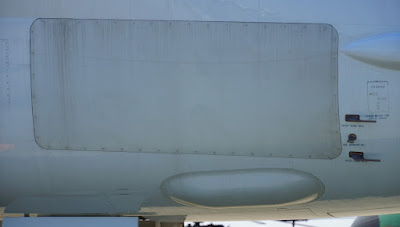Following
Australia past the mid 2020s - Some Strategic Thoughts parts
1and
2of 5 the question is posed
North Korea and Trump's Surprises are unnerving the East Asian - Australian region towards a conclusion that Australia should nuclear arm itself.
But where does Australia start?
Look at history and likely information already on file:
"There are many countries capable of producing nuclear weapons, or at least enriching uranium and / or plutonium. Among the most notable are Canada, Germany, and
Australia.
[10] Other
countries include
Mexico,
Argentina,
South Korea, the
Republic of China, and more.
[11] In addition,
South Africa has successfully developed
its own nuclear weapons, but dismantled them
in 1989." https://en.wikipedia.org/wiki/Nuclear_latency
------------------------------------------------------------------------------
The push for nuclear weapons in Australia 1950s-1970s
NUCLEAR WEAPONS FOR AUSTRALIA: [Pete has bolded very notable parts]
"...There were ongoing efforts through the 1950s and 1960s to procure nuclear-capable delivery systems [for Australia]. The 1963 contract to buy F-111s bombers from the US was partly motivated by the capacity to modify them to carry nuclear weapons. Moreover, their range of 2000 nautical miles made them suitable for strikes on Indonesia, which was seen to be anti-British and anti-imperialist under Sukarno's presidency.
[AUSTRALIAN] DOMESTIC WEAPONS PRODUCTION
In the 1960s the interest in nuclear weapons was spurred on by China's development of nuclear weapons, Britain's decision to withdraw troops from the Pacific, and American withdrawal from Vietnam.
From the mid-1960s to the early 1970s, there was greater interest in the domestic [Australian] manufacture of nuclear weapons. It is unclear why the focus shifted from attempts to purchase weapons to a greater interest in domestic production; perhaps the main reason was that so little had been achieved through negotiations with the US and the UK.
In 1965, the [Australian Atomic Energy Commission] AAEC and the Department of Supply were commissioned to examine all aspects of Australia's policy towards nuclear weapons and the cost of establishing a nuclear weapons program in Australia.
The AAEC began a uranium enrichment research program in 1965. For the first two years, this program was carried out in secret because of fears that public knowledge of the project would lead to allegations of intentions to build enriched uranium bombs. There were several plausible justifications for the enrichment project, such as the potential profit to be made by exporting enriched uranium. While there is no concrete evidence, it can safely be assumed that the potential to produce weapons-grade enriched uranium counted in favour of the government's decision to approve and fund the enrichment research.
[long term Australian Prime Minister] Menzies retired in January 1966. The new prime minister, Harold Holt, soon faced a dilemma. The US requested that a bilateral safeguards agreement between the US and Australia be transferred to the IAEA. The Australian government opposed the move for fear it would close off the nuclear weapons option. Opposition to the safeguards transfer was sufficiently strong that some Cabinet members thought it would be preferable to close the Lucas Heights research reactor rather than comply with the request. (The previous year there were Cabinet discussions on the potential for nuclear transfers from France which would not be subject to safeguards.)
Cabinet agreed to the US request in June 1966, but only after being reassured by defence officials that IAEA safeguards would not directly affect a nuclear weapons program.Despite the glut in the uranium market overseas, the Minister for National Development announced in 1967 that uranium companies would henceforth have to keep half of their known reserves for Australian use, and he acknowledged in public that this decision was taken because of a desire to have a domestic uranium source in case it was needed for nuclear weapons.
In May 1967 Prime Minister Holt and the Cabinet's Defence Committee commissioned another study to assess the possibility of domestic manufacture of nuclear weapons, as well as "possible arrangements with our allies."
It is not known how seriously Holt might have pursued nuclear weapons. In December 1967 he disappeared while swimming off Port Phillip Bay near Melbourne. The new prime minister was John Gorton, who was on public record as an advocate of the production or acquisition of nuclear weapons.
By the mid-1960s, the AAEC had become the leading voice on nuclear affairs, thanks in large part to its influential chairman Philip Baxter. According to Walsh (1997), "Baxter personally supported the concept of an Australian nuclear weapons capability and, perhaps more importantly, viewed the military's interest in nuclear weapons as consonant with the AAEC's need to expand its programs and budget."
NON-PROLIFERATION TREATY
The intention to leave open the nuclear weapons option was evident in the government's approach to the Nuclear Non-Proliferation Treaty (NPT) from 1969-71. Gorton was determined not to sign the NPT, and he had some powerful allies such as Baxter. The Minister for National Development admitted that a sticking point was a desire not to close off the weapons option.
During the election campaign of late 1969, Gorton said that in the absence of major changes, Australia would not sign the NPT. But on February 19, 1970, Gorton announced that Australia would sign, but not ratify, the treaty. He noted that the treaty would not be binding until ratified.
Why the decision to sign the NPT? Pressure from the US had an impact. In addition, there were some significant signings from countries such as Switzerland, Italy, Japan and West Germany in the months preceding Australia's decision to sign.
Another possible reason was the possibility that weapons production could be pursued even as an NPT signatory. The "sign-and-pursue" option would have raised some difficulties, but it had advantages including greater access to overseas nuclear technology and less suspicion regarding Australia's intentions. The Department of External Affairs argued that it was possible for a signatory to
develop nuclear technology to the brink of making a nuclear weapons without contravening the NPT.(On the NPT saga, see Encel and McKnight (1970), Walsh (1997), Cawte (1992).)..."
More history in part 4 of 5.








